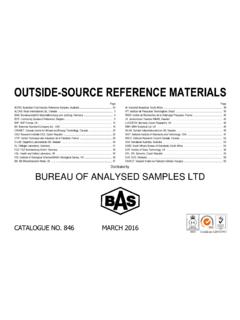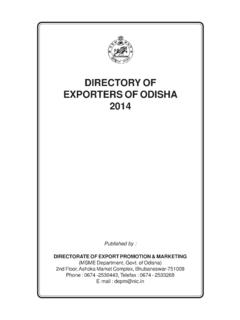Transcription of Competitiveness and challenges in the steel industry
1 Competitiveness and challenges in the steel industry OECD steel committee 74th session Paris, July 1, 2013. CONFIDENTIAL AND PROPRIETARY. Any use of this material without specific permission of McKinsey & Company is strictly prohibited Disclaimer While McKinsey & Company developed the outlooks and scenarios in accordance with its professional standards, McKinsey&Company does not warrant any results obtained or conclusions drawn from their use. The analyses and conclusions contained in this document are based on various assumptions that McKinsey&Company has developed regarding economic growth, and steel demand, production and capacities which may or may not be correct, being based upon factors and events subject to uncertainty. Future results or values could be materially different from any forecast or estimates contained in the analyses. The analyses are partly based on information that has not been generated by McKinsey&Company and has not, therefore, been entirely subject to our independent verification.
2 McKinsey believes such information to be reliable and adequately comprehensive but does not represent that such information is in all respects accurate or complete. McKinsey & Company | 1. Contents challenges in the steel industry . cyclicality and increasing competition from emerging economies Competitiveness of the steel industry beyond cost optimization Implications for enhancing competitive- ness few actions to launch and promote McKinsey & Company | 2. The development of the industrial production index shows fundamental differences by region Industrial production index mature regions Points (based on 2005) China: 600 Europe China and Western Europe North America 500 are the dominant players in Europe (EU15) global consumers 400. 300 While projections on China 200 are positive, mature regions 100 suffer from no growth 0. 2008 09 10 11 12 13 14 15 16 17 18 19 2020. Years Industrial production index developing regions Points (based on 2005). 250 Emerging regions follow a Latin America Dev Asia +6% 200 growth trend line over the MENA.
3 Next few years 150 Africa In all of those regions next to 100 GDP growth, some countries have clear growth 50 stimulating drivers such as 0 energy and resources 2008 09 10 11 12 13 14 15 16 17 18 19 2020. Years SOURCE: Global Insight; McKinsey McKinsey & Company | 3. Within major steel economies macro-economic factors indicate uncertainty for demand and utilization Debt GDP ratio Economically Index (based on 2005). uncertain markets in 2,0 traditional steel - US consuming econo- 1,5 EU-15 mies 1,0 GER China's economy China stabilizes while the 0,5 debt to GDP ratio in the US and EU-15. 0 has been increasing 2005 06 07 08 09 10 11 12 13 14 15 2016 steadily since 2008 in combination with Infrastructure spending strongly declining Index (based on 2005) infrastructural investments 4,0. In addition to weak China 3,0 GDP growth and higher debts, infra- 2,0 GER structure investments US in EU-15 countries 1,0. have declined more EU-15 than 30% between 0. 2005 06 07 08 09 10 11 12 13 14 15 2016 2011 and 2012.
4 SOURCE: Global insight; McKinsey McKinsey & Company | 4. Current projections based on consumption forecasts indicate a global slow-down Apparent steel demand per region Million metric tons Regional growth Percent 1,797 2010 - 16 2016 - 20. 1,702. 176 1 1. 1,607. 172. 1,500 167 128 4 1. 1,413 125. 153 141 1 0. 1,306 148 122. 141. 119. Europe 153 113 141. 143. North America 94 141. Developed Asia 134 794 4 2. 765. 730. 686. 646. China 589. 120 6 7. 106. 93. 72 81. India 65. 394 439 5 5. 293 318 354. Other1 270. 2010 12 14 16 18 2020. Share of China 45 46 46 45 45 44. Percent 1 Africa, other Asia, CIS, Oceania, MENA, Latin America SOURCE: World steel Association (WSA); McKinsey steel Demand Model McKinsey & Company | 5. The steel industry is very volatile and with depressed profitability since 2008 mature regions are losing in profitability China Developed Asia Average EBITDA margin Percent1 Europe NAFTA. 30 2003 - 08: margin 2000 - 03: price- improvement and 2008 - 12: margin deterio- 25 margin squeeze upstream integration ration and leveraging Margin develop- 20 ment follows a 15 negative trend line Current 10 situation worst for a 5 long time 0.
5 -5. 2000 01 02 03 04 05 06 07 08 09 10 11 2012. 1 Based on a sample of 84 of the largest steel companies globally SOURCE: Bloomberg; McKinsey analysis McKinsey & Company | 6. Within the entire steel value chain, profitability is challenged and margins move to mining HRC value chain1 profit pool split evolution since 1995, USD billions 100% = 54 23 125 156 230 135. Iron ore 8. In the medium 15 17 term, the value Coking 11 pool in steel will coal 7. 44 42 remain in favor of 46. 22 the raw material producers There might be shifts in between steel 22 years, but making 81 32. 78 28 demand and (HRC) supply for steel 61. combined with 35. cost for marginal 26 27 producers will stabilize EBITDA. distribution 1995 2000 05 10 2011 2017. 1 HRC assumed to represent 85% of total hot-rolled flat products. Flat production assumed to use 85% of pig iron as raw materials. Assuming t of iron ore per tonne of pig iron and tonne of coke per tonne of pig iron SOURCE: McKinsey steel Model, McKinsey Mining Value Pools Model McKinsey & Company | 7.
6 From a perspective on the EBITDA pool, emerging regions benefited most from the China-driven boom of the last decade HRC value chain EBITDA pool Mining Non-OECD steel OECD steel USD billions CAGR. 2003 - 2012. 164 17%. 136. 38. 121 33%. 56. 58. 39. 37. 10 9%. 28. 13 42. 14. 16 7 15 -1%. 2003 2007 2009 20121. 1 Based on preliminary estimates SOURCE: McKinsey (BMI Value Pools Model) McKinsey & Company | 8. Contents challenges in the steel industry . cyclicality and increasing competition from emerging economies Competitiveness of the steel industry beyond cost optimization Implications for enhancing competitive- ness few actions to launch and promote McKinsey & Company | 9. Margin development in steel is a major issue, driven by external factors and plant situation 1 Development of industry attractiveness USD per ton of HRC Typical factors driving/challenging Competitiveness Brazil 2 Supply balance CO2 and technology 922 challenges 753 . industry - 462 wide 460 497 factors 256.
7 Price Cost EBITDA Price Cost EBITDA. 2008 2012 Intrinsic Regional industry factors Western Europe player and conse- actions quences 953. 657. 698. 255 622 4 Asset quality 3 Access to raw and actions materials/resources 35. Operational Fx-rate and cost performance inflation Price Cost EBITDA Price Cost EBITDA. Regulation 2008 2012 . SOURCE: SBB, MEPS, McKinsey Flat steel database McKinsey & Company | 10. 1 Globally Competitiveness of some regions gets challenged through erosion of cost position example Europe/Germany Europe 1st quartile Global HRC cost curve1, ex works, USD/t Other 2002 German plants Marginal 800 1st quartile manufacturer 600 Europe 400 ~ 55%. 200. 0. Q1 2013 1st quartile Marginal Europe manufacturer2. 800 ~ 47%. 600. 400. 200. 0. Marginal 1st quartile manufacturer2. Europe 2017E. 800 33%. 600. 400. 200. 0. 0 50 100 150 200 250 300 350 400 450 500 550 600 650 700 750 800 850 900. Cumulative capacity, Mt 1 Operating costs excluding SG&A, considering captive raw materials, standard utilization (90%).
8 2 90% of capacity SOURCE: McKinsey flat steel cost model; steel press; VDEh; WSA McKinsey & Company | 11. Direct emissions 2 steel will remain a source of CO2 emissions which is a Indirect emissions consequence of the process . Percent, 2010e Global CO2e emissions steel CO2e emissions 100% = GtCO2e per year 100% = GtCO2e per year Ferro-alloys2. Agriculture 4. Mining1. Power 17. steel (Power). Forestry steel (Direct) Power 9. 1. steel (mining 2. and ferro-alloys ). Waste Petroleum 70. and gas Direct Building Cement Chemicals Transport Other industry 1 Includes mining and beneficiation of iron ore, coal, limestone, and ferro-alloy ores 2 Production of Ni, FeCr, FeSi, FeMn, SiMn and Al consumed during steel production SOURCE: McKinsey ( steel CO2 Model; Global Carbon Cost Curve ) McKinsey & Company | 12. 2 however, technology differences can lead to significant differences in emissions BF route PCI coal Ferroalloys Coke Fuel (including Electricity Pig Iron Limestone Mining smelting off-gas).
9 Mining and raw Coke Sintering /. material BF BOF Downstream making Pelletizing processing About for transportation 21% Technology of raw materials 4% 2% differences not included About for 6%. 10% between transportation 12% integrated of finished route and products 43% EAF route not included result in significant emission levels EAF route However, Ferroalloys Fuel (including Coke Mining Pig Iron & DRI Electricity input factor smelting off-gas) salso change EAF route Mining and raw require material Pelletizing DRI making EAF Downstream additional processing power supply About for transportation 8%. of raw materials not included 39%. About for transportation 0 33%. of finished products 5%. not included Total CO2 footprint 1 CO2 emissions linked to off-gas are allocated to the process step where the gas is used SOURCE: McKinsey steel CO2 Model McKinsey & Company | 13. 3 Some raw material supplying countries get challenged by appreciation of their currencies and cost inflation Currency development of "commodity countries" Price evolution Exchange rate changes Consumer price index growth (2006 - 13) (2006 - 13).
10 Commodity countries Percent Percent 37 exposed to external 41. factors Cost base for raw materials inflating The rationale that inflation results in devaluation does no longer seem to hold true 19. Overall economics of raw 15 15. 11 material countries will challenge markets (higher cost makes steel 2 less attractive). EUR/ REAL/ AUS/ US Europe1 Australia Brazil USD USD USD. 1 Eurozone countries SOURCE: Global Insight; OANDA; McKinsey McKinsey & Company | 14. 3 Brasil shows how regionally attractivity of a production base can deteriorated Development of factor costs in Brazil Million metric tons Supply chain cost Energy cost Labor cost USD transport cost/t coking USD/MWh USD/hour coal 180 17. +52%. 11. +288% +272%. 46 2003 2012 2003 2012 2003 2012. SOURCE: Minist rio das Minas e Energia, Aneel, Economist Intelligence Unit, James F. King McKinsey & Company | 15. 3 Also, import and export taxes influence Competitiveness , while EXAMPLES. protecting or even taking away the need for continuous improvement Import duties for steel products Export barriers for raw materials Import duties and taxes1 Semi-finished products Export duties, iron ore India Percent Finished iron & steel products Percent Export bans 18 20.













